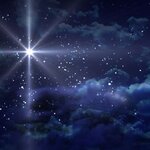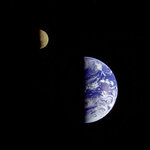Space

During winter it can sometimes feel that the whole day passes in the blink of an eye and that evening darkness comes far too quickly. While more daylight would be a lovely thing, the early darkness has one big advantage: the stars. On a clear evening you can look up and see far into space. I’ve spent many winter evenings with my children, on our way home from activities, looking for Orion (and other constellations), following its path through the seasons.
Stars and space are two of the most popular science topics, whatever the age of the child. There’s something awe-inspiring and beautiful…

Astrophysicists have obtained precise measurements for an object orbiting a black hole five billion light years away - and the innermost region of a disc of matter in orbital motion around a supermassive black hole tucked inside the quasar known as Einstein’s Cross (Q2237-0305).
This constitutes the most precise set of measurements achieved to date for such a small and distant object, and was made possible thanks to years of monitoring as part of the OGLE and GLITP gravitational microlensing projects, which have had their lenses trained on this quasar for 12 and 9 years, respectively.…

Thick donut-shaped disks of gas and dust that surround most massive black holes in the universe are 'clumpy' rather than smooth as originally thought, according to a new study.
Until recently, telescopes weren't able to penetrate some of these donuts, also known as tori, which feed and nourish the growing black holes tucked inside.
The study was co-authored by Dr Poshak Gandhi of the University of Southampton, described results from NASA's Nuclear Spectroscopic Telescope Array (NuSTAR) and the European Space Agency's XMM-Newton space observatory. With its X-ray vision, NuSTAR recently peered…

By Marsha Lewis, Inside Science TV. The moon — it can appear full, shining like a beacon in the night or just a sliver of a nightlight. Still, it’s always there.
Image Credit: NASA.gov
But what if we didn't have a moon?
Here’s the top five things we would miss without it.
1. Nights would be much, much darker. The next brightest object in the night sky is Venus – but it still wouldn’t be enough to light up the sky – a full moon is nearly two thousand times brighter than Venus is at its brightest.
2. Without the moon, a…

Astronomers discovered a nest of monstrous baby galaxies 11.5 billion light-years away and they speculate that the galaxies seem to reside at the junction of gigantic filaments in a web of dark matter.
Since dark matter is the umbrella term for matter that inference says must exist but which has never been detected, how can they know the galaxies are surrounded by it? Read on. Thugh things are relatively quiet now, ten billion years ago, long before the Sun and Earth were formed, areas of the Universe were inhabited by monstrous galaxies with star formation rates hundreds or thousands…

Sometimes it's quite hard to tell if an article is sensible, especially if you don't know much science. But there is one thing anyone can do, quite easily - and that is to check sources. I'll do this for the "Nibiru" nonsense stories so you can see how this works. The most unreliable and nonsense stories, as well as getting the science wrong, also tend to get their sources wrong as well, so this can be a good test to check for unreliable news stories.
As an example, a recent "Nibiru" story in the Daily Star says that a tenth planet was discovered in 1983.
Now you can go to one of the…

Fast Radio Bursts - bursts of energy from space that appear as a short flashes of radio waves to telescopes on Earth - have baffled astronomers since first detected a decade ago.
Though only 16 have been recorded, there could be thousands of of these mysterious events each day.
At least one may be a little closer to being better known, thanks to analysis of data recorded during radio astronomy observations. The origin of a newly discovered Fast Radio Burst may be tied to a highly magnetized, gas-filled region of space, providing a new hint in the decade-long quest to explain the…

Discussions of the ethics of terraforming often touch on rights of planets or extraterrestrial lifeforms, or near term utilitarian values. But what about our responsibilities to terraformed worlds, and their long term future? I suggest that we are nowhere near mature enough as a civilization to be responsible parents to a newly terraformed world with a gestation period of millennia and an "adult life" of hundreds of millions of years. Though we could be reasonable parents to Moon city domes or Stanford Torus type habitats and the like.
Mars is the planet most people think…

Our Sun is a relatively quiet star that only occasionally releases solar flares or blasts of energetic particles that threaten satellites and power grids. You might think that smaller, cooler stars would be even more sedate. However, astronomers have now identified a tiny star with a monstrous temper. It shows evidence of much stronger flares than anything our Sun produces. If similar stars prove to be just as stormy, then potentially habitable planets orbiting them are likely to be much less hospitable than previously thought.
"If we lived around a star like this one, we wouldn't have any…

Dark matter is "dark" because no one knows what it is and a blanket term for whatever outnumbers particles of regular matter by more than a factor of 10 is necessary.
Because it can't be detected, dark matter is inferred by gravitational influence in galaxies, and by measuring the mass of a nearby dwarf galaxy called Triangulum II, Assistant Professor of Astronomy Evan Kirby says they may have found the highest concentration of dark matter in any known galaxy.
Triangulum II is a small, faint galaxy at the edge of the Milky Way, made up of only about 1,000 stars. Kirby measured the mass…